Comprehensive Analysis of Unilever's Business and Environment
VerifiedAdded on 2023/01/17
|7
|2485
|63
Report
AI Summary
This report provides a detailed analysis of Unilever, a British-Dutch transnational consumer goods organization. It begins by defining business and the business environment, then categorizes different types of organizations like public, private, and voluntary sectors. The report explores the legal structures within the private sector, focusing on sole traders, partnerships, and private limited companies. It evaluates Unilever's organizational structure, size, and scope, highlighting its divisional structure and global operations. Furthermore, the report analyzes the complexities of different business structures and the crucial interrelationship of various organizational functions, such as human resources, marketing, finance, and production, emphasizing their impact on the overall business operations. The report concludes by summarizing the key aspects of business, the environment, and the significance of organizational structure and functional relationships within a company like Unilever.
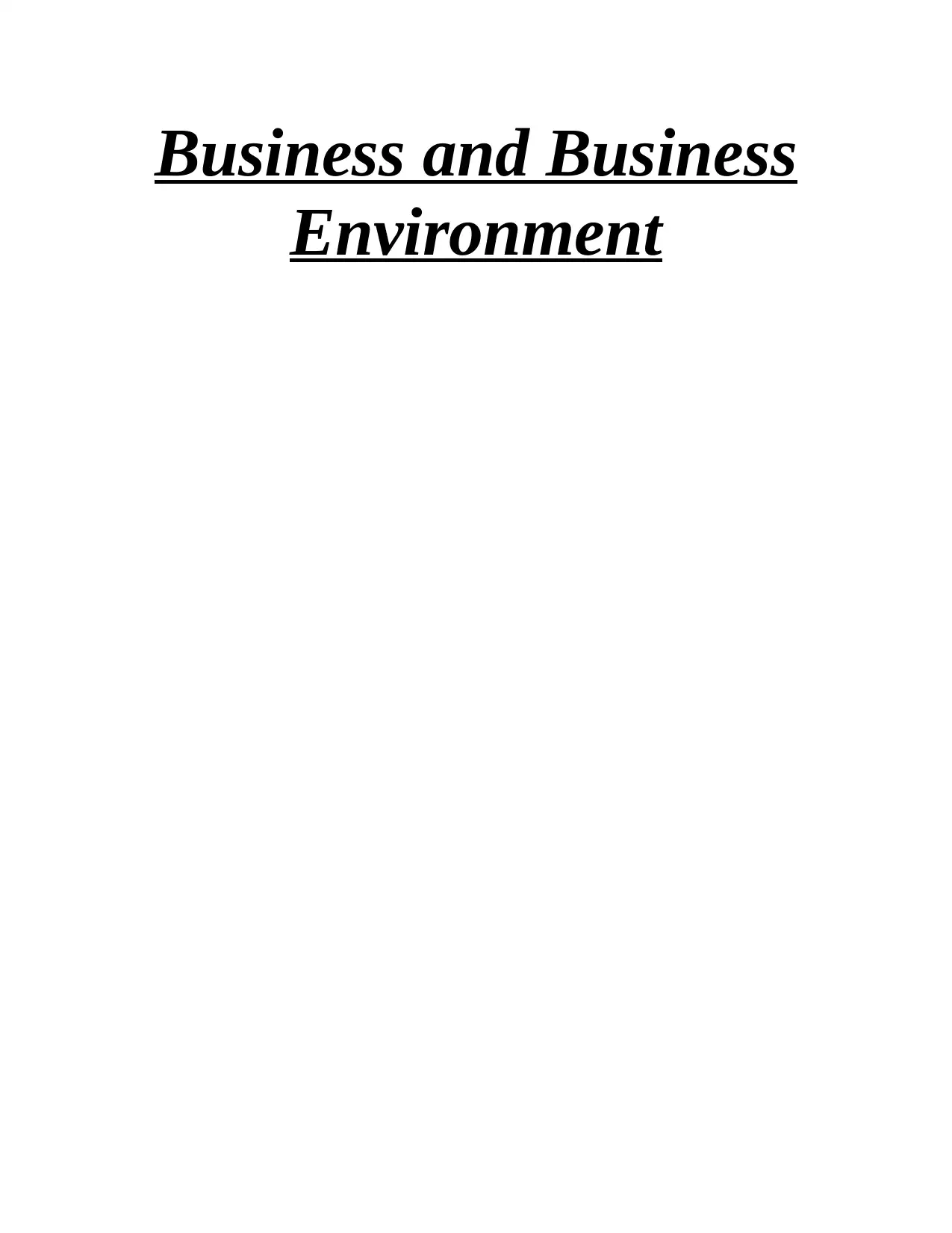
Business and Business
Environment
Environment
Paraphrase This Document
Need a fresh take? Get an instant paraphrase of this document with our AI Paraphraser
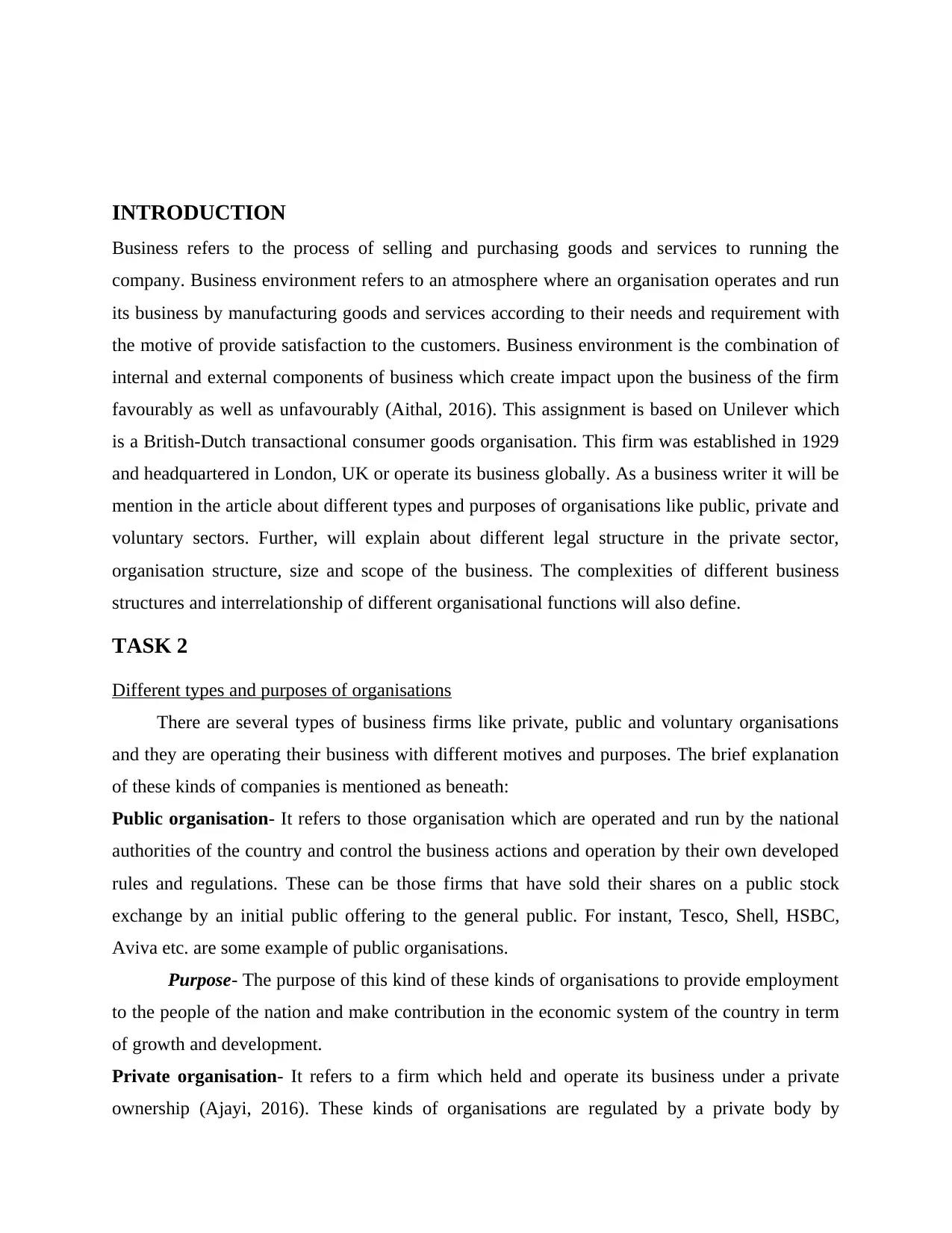
INTRODUCTION
Business refers to the process of selling and purchasing goods and services to running the
company. Business environment refers to an atmosphere where an organisation operates and run
its business by manufacturing goods and services according to their needs and requirement with
the motive of provide satisfaction to the customers. Business environment is the combination of
internal and external components of business which create impact upon the business of the firm
favourably as well as unfavourably (Aithal, 2016). This assignment is based on Unilever which
is a British-Dutch transactional consumer goods organisation. This firm was established in 1929
and headquartered in London, UK or operate its business globally. As a business writer it will be
mention in the article about different types and purposes of organisations like public, private and
voluntary sectors. Further, will explain about different legal structure in the private sector,
organisation structure, size and scope of the business. The complexities of different business
structures and interrelationship of different organisational functions will also define.
TASK 2
Different types and purposes of organisations
There are several types of business firms like private, public and voluntary organisations
and they are operating their business with different motives and purposes. The brief explanation
of these kinds of companies is mentioned as beneath:
Public organisation- It refers to those organisation which are operated and run by the national
authorities of the country and control the business actions and operation by their own developed
rules and regulations. These can be those firms that have sold their shares on a public stock
exchange by an initial public offering to the general public. For instant, Tesco, Shell, HSBC,
Aviva etc. are some example of public organisations.
Purpose- The purpose of this kind of these kinds of organisations to provide employment
to the people of the nation and make contribution in the economic system of the country in term
of growth and development.
Private organisation- It refers to a firm which held and operate its business under a private
ownership (Ajayi, 2016). These kinds of organisations are regulated by a private body by
Business refers to the process of selling and purchasing goods and services to running the
company. Business environment refers to an atmosphere where an organisation operates and run
its business by manufacturing goods and services according to their needs and requirement with
the motive of provide satisfaction to the customers. Business environment is the combination of
internal and external components of business which create impact upon the business of the firm
favourably as well as unfavourably (Aithal, 2016). This assignment is based on Unilever which
is a British-Dutch transactional consumer goods organisation. This firm was established in 1929
and headquartered in London, UK or operate its business globally. As a business writer it will be
mention in the article about different types and purposes of organisations like public, private and
voluntary sectors. Further, will explain about different legal structure in the private sector,
organisation structure, size and scope of the business. The complexities of different business
structures and interrelationship of different organisational functions will also define.
TASK 2
Different types and purposes of organisations
There are several types of business firms like private, public and voluntary organisations
and they are operating their business with different motives and purposes. The brief explanation
of these kinds of companies is mentioned as beneath:
Public organisation- It refers to those organisation which are operated and run by the national
authorities of the country and control the business actions and operation by their own developed
rules and regulations. These can be those firms that have sold their shares on a public stock
exchange by an initial public offering to the general public. For instant, Tesco, Shell, HSBC,
Aviva etc. are some example of public organisations.
Purpose- The purpose of this kind of these kinds of organisations to provide employment
to the people of the nation and make contribution in the economic system of the country in term
of growth and development.
Private organisation- It refers to a firm which held and operate its business under a private
ownership (Ajayi, 2016). These kinds of organisations are regulated by a private body by
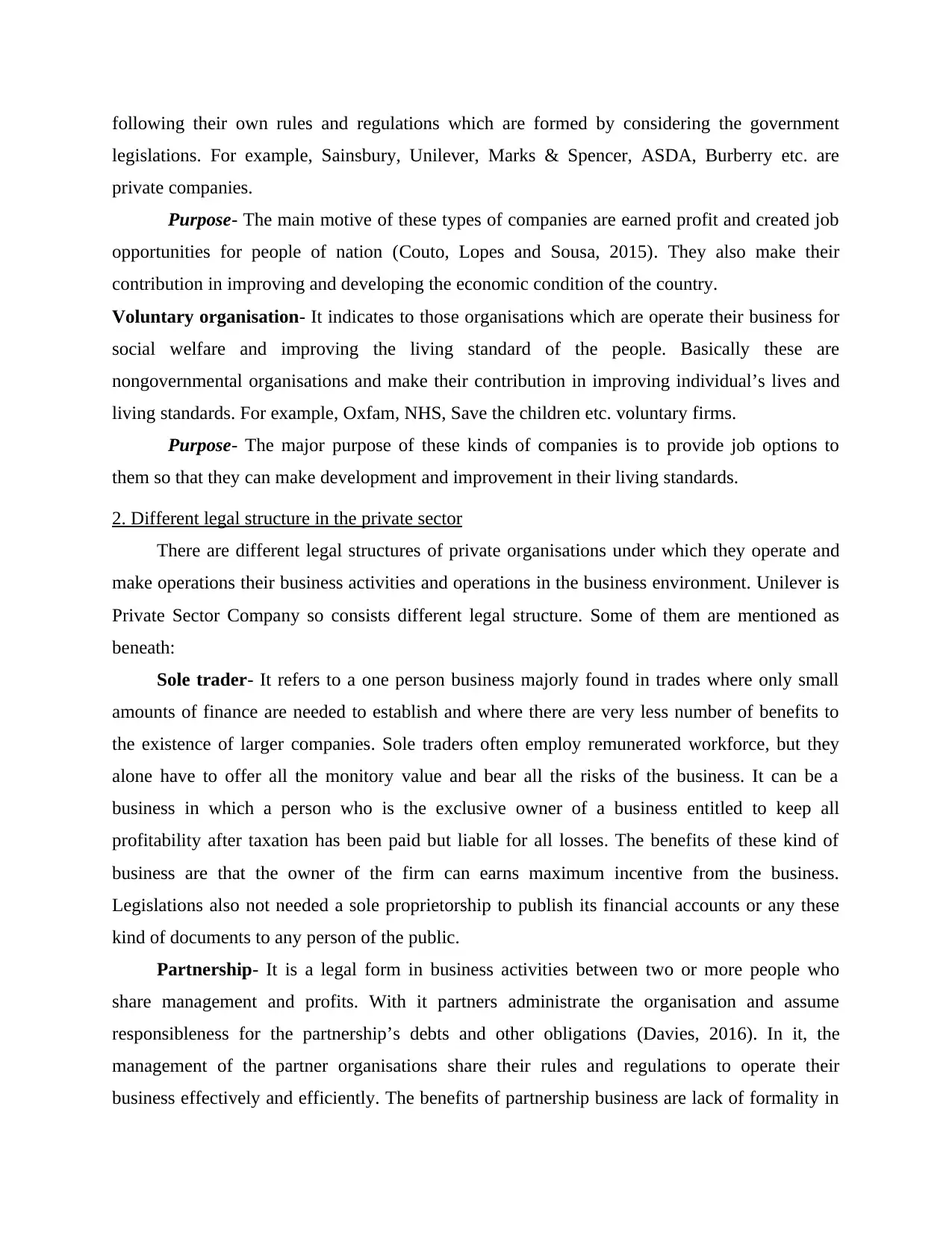
following their own rules and regulations which are formed by considering the government
legislations. For example, Sainsbury, Unilever, Marks & Spencer, ASDA, Burberry etc. are
private companies.
Purpose- The main motive of these types of companies are earned profit and created job
opportunities for people of nation (Couto, Lopes and Sousa, 2015). They also make their
contribution in improving and developing the economic condition of the country.
Voluntary organisation- It indicates to those organisations which are operate their business for
social welfare and improving the living standard of the people. Basically these are
nongovernmental organisations and make their contribution in improving individual’s lives and
living standards. For example, Oxfam, NHS, Save the children etc. voluntary firms.
Purpose- The major purpose of these kinds of companies is to provide job options to
them so that they can make development and improvement in their living standards.
2. Different legal structure in the private sector
There are different legal structures of private organisations under which they operate and
make operations their business activities and operations in the business environment. Unilever is
Private Sector Company so consists different legal structure. Some of them are mentioned as
beneath:
Sole trader- It refers to a one person business majorly found in trades where only small
amounts of finance are needed to establish and where there are very less number of benefits to
the existence of larger companies. Sole traders often employ remunerated workforce, but they
alone have to offer all the monitory value and bear all the risks of the business. It can be a
business in which a person who is the exclusive owner of a business entitled to keep all
profitability after taxation has been paid but liable for all losses. The benefits of these kind of
business are that the owner of the firm can earns maximum incentive from the business.
Legislations also not needed a sole proprietorship to publish its financial accounts or any these
kind of documents to any person of the public.
Partnership- It is a legal form in business activities between two or more people who
share management and profits. With it partners administrate the organisation and assume
responsibleness for the partnership’s debts and other obligations (Davies, 2016). In it, the
management of the partner organisations share their rules and regulations to operate their
business effectively and efficiently. The benefits of partnership business are lack of formality in
legislations. For example, Sainsbury, Unilever, Marks & Spencer, ASDA, Burberry etc. are
private companies.
Purpose- The main motive of these types of companies are earned profit and created job
opportunities for people of nation (Couto, Lopes and Sousa, 2015). They also make their
contribution in improving and developing the economic condition of the country.
Voluntary organisation- It indicates to those organisations which are operate their business for
social welfare and improving the living standard of the people. Basically these are
nongovernmental organisations and make their contribution in improving individual’s lives and
living standards. For example, Oxfam, NHS, Save the children etc. voluntary firms.
Purpose- The major purpose of these kinds of companies is to provide job options to
them so that they can make development and improvement in their living standards.
2. Different legal structure in the private sector
There are different legal structures of private organisations under which they operate and
make operations their business activities and operations in the business environment. Unilever is
Private Sector Company so consists different legal structure. Some of them are mentioned as
beneath:
Sole trader- It refers to a one person business majorly found in trades where only small
amounts of finance are needed to establish and where there are very less number of benefits to
the existence of larger companies. Sole traders often employ remunerated workforce, but they
alone have to offer all the monitory value and bear all the risks of the business. It can be a
business in which a person who is the exclusive owner of a business entitled to keep all
profitability after taxation has been paid but liable for all losses. The benefits of these kind of
business are that the owner of the firm can earns maximum incentive from the business.
Legislations also not needed a sole proprietorship to publish its financial accounts or any these
kind of documents to any person of the public.
Partnership- It is a legal form in business activities between two or more people who
share management and profits. With it partners administrate the organisation and assume
responsibleness for the partnership’s debts and other obligations (Davies, 2016). In it, the
management of the partner organisations share their rules and regulations to operate their
business effectively and efficiently. The benefits of partnership business are lack of formality in
⊘ This is a preview!⊘
Do you want full access?
Subscribe today to unlock all pages.

Trusted by 1+ million students worldwide
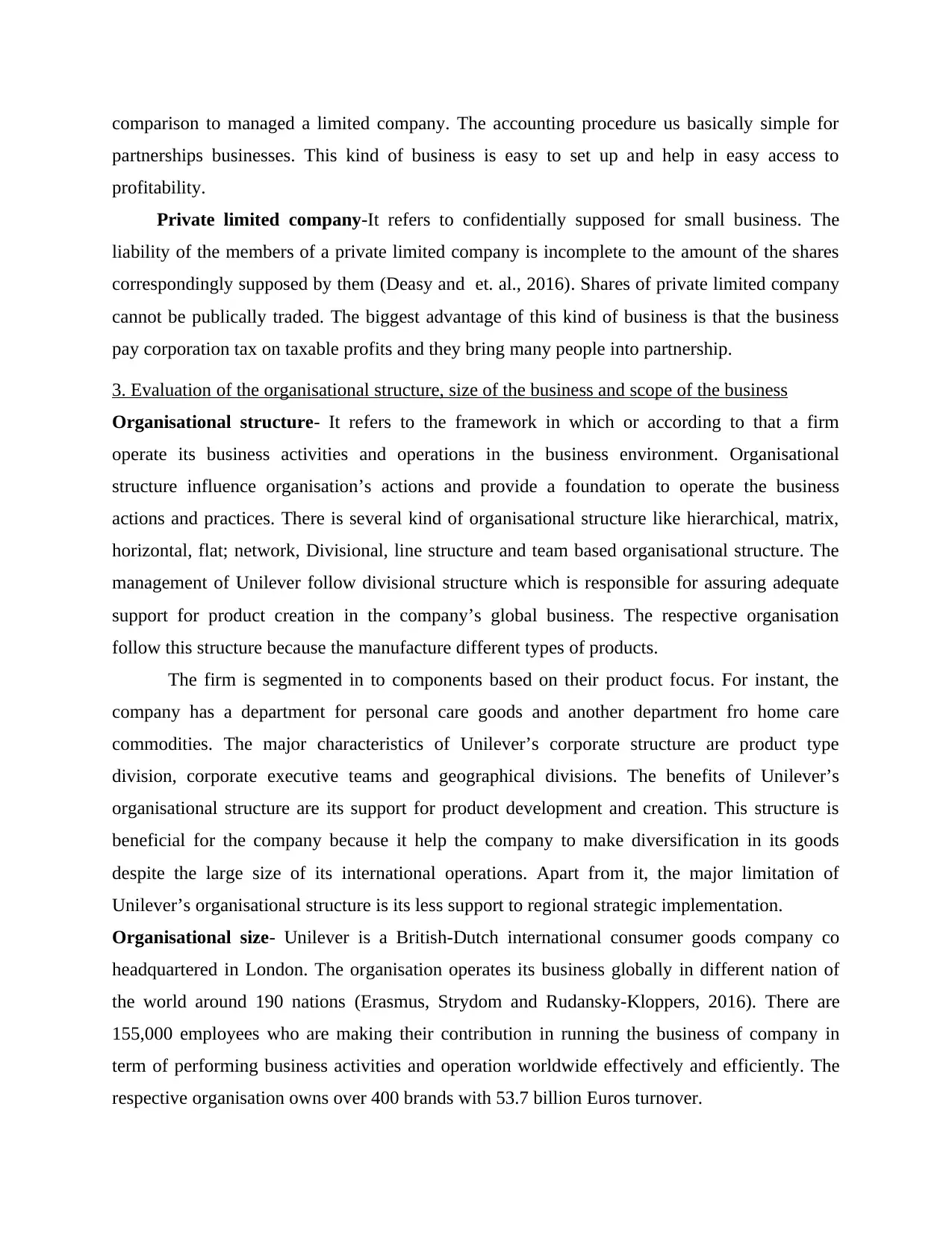
comparison to managed a limited company. The accounting procedure us basically simple for
partnerships businesses. This kind of business is easy to set up and help in easy access to
profitability.
Private limited company-It refers to confidentially supposed for small business. The
liability of the members of a private limited company is incomplete to the amount of the shares
correspondingly supposed by them (Deasy and et. al., 2016). Shares of private limited company
cannot be publically traded. The biggest advantage of this kind of business is that the business
pay corporation tax on taxable profits and they bring many people into partnership.
3. Evaluation of the organisational structure, size of the business and scope of the business
Organisational structure- It refers to the framework in which or according to that a firm
operate its business activities and operations in the business environment. Organisational
structure influence organisation’s actions and provide a foundation to operate the business
actions and practices. There is several kind of organisational structure like hierarchical, matrix,
horizontal, flat; network, Divisional, line structure and team based organisational structure. The
management of Unilever follow divisional structure which is responsible for assuring adequate
support for product creation in the company’s global business. The respective organisation
follow this structure because the manufacture different types of products.
The firm is segmented in to components based on their product focus. For instant, the
company has a department for personal care goods and another department fro home care
commodities. The major characteristics of Unilever’s corporate structure are product type
division, corporate executive teams and geographical divisions. The benefits of Unilever’s
organisational structure are its support for product development and creation. This structure is
beneficial for the company because it help the company to make diversification in its goods
despite the large size of its international operations. Apart from it, the major limitation of
Unilever’s organisational structure is its less support to regional strategic implementation.
Organisational size- Unilever is a British-Dutch international consumer goods company co
headquartered in London. The organisation operates its business globally in different nation of
the world around 190 nations (Erasmus, Strydom and Rudansky-Kloppers, 2016). There are
155,000 employees who are making their contribution in running the business of company in
term of performing business activities and operation worldwide effectively and efficiently. The
respective organisation owns over 400 brands with 53.7 billion Euros turnover.
partnerships businesses. This kind of business is easy to set up and help in easy access to
profitability.
Private limited company-It refers to confidentially supposed for small business. The
liability of the members of a private limited company is incomplete to the amount of the shares
correspondingly supposed by them (Deasy and et. al., 2016). Shares of private limited company
cannot be publically traded. The biggest advantage of this kind of business is that the business
pay corporation tax on taxable profits and they bring many people into partnership.
3. Evaluation of the organisational structure, size of the business and scope of the business
Organisational structure- It refers to the framework in which or according to that a firm
operate its business activities and operations in the business environment. Organisational
structure influence organisation’s actions and provide a foundation to operate the business
actions and practices. There is several kind of organisational structure like hierarchical, matrix,
horizontal, flat; network, Divisional, line structure and team based organisational structure. The
management of Unilever follow divisional structure which is responsible for assuring adequate
support for product creation in the company’s global business. The respective organisation
follow this structure because the manufacture different types of products.
The firm is segmented in to components based on their product focus. For instant, the
company has a department for personal care goods and another department fro home care
commodities. The major characteristics of Unilever’s corporate structure are product type
division, corporate executive teams and geographical divisions. The benefits of Unilever’s
organisational structure are its support for product development and creation. This structure is
beneficial for the company because it help the company to make diversification in its goods
despite the large size of its international operations. Apart from it, the major limitation of
Unilever’s organisational structure is its less support to regional strategic implementation.
Organisational size- Unilever is a British-Dutch international consumer goods company co
headquartered in London. The organisation operates its business globally in different nation of
the world around 190 nations (Erasmus, Strydom and Rudansky-Kloppers, 2016). There are
155,000 employees who are making their contribution in running the business of company in
term of performing business activities and operation worldwide effectively and efficiently. The
respective organisation owns over 400 brands with 53.7 billion Euros turnover.
Paraphrase This Document
Need a fresh take? Get an instant paraphrase of this document with our AI Paraphraser
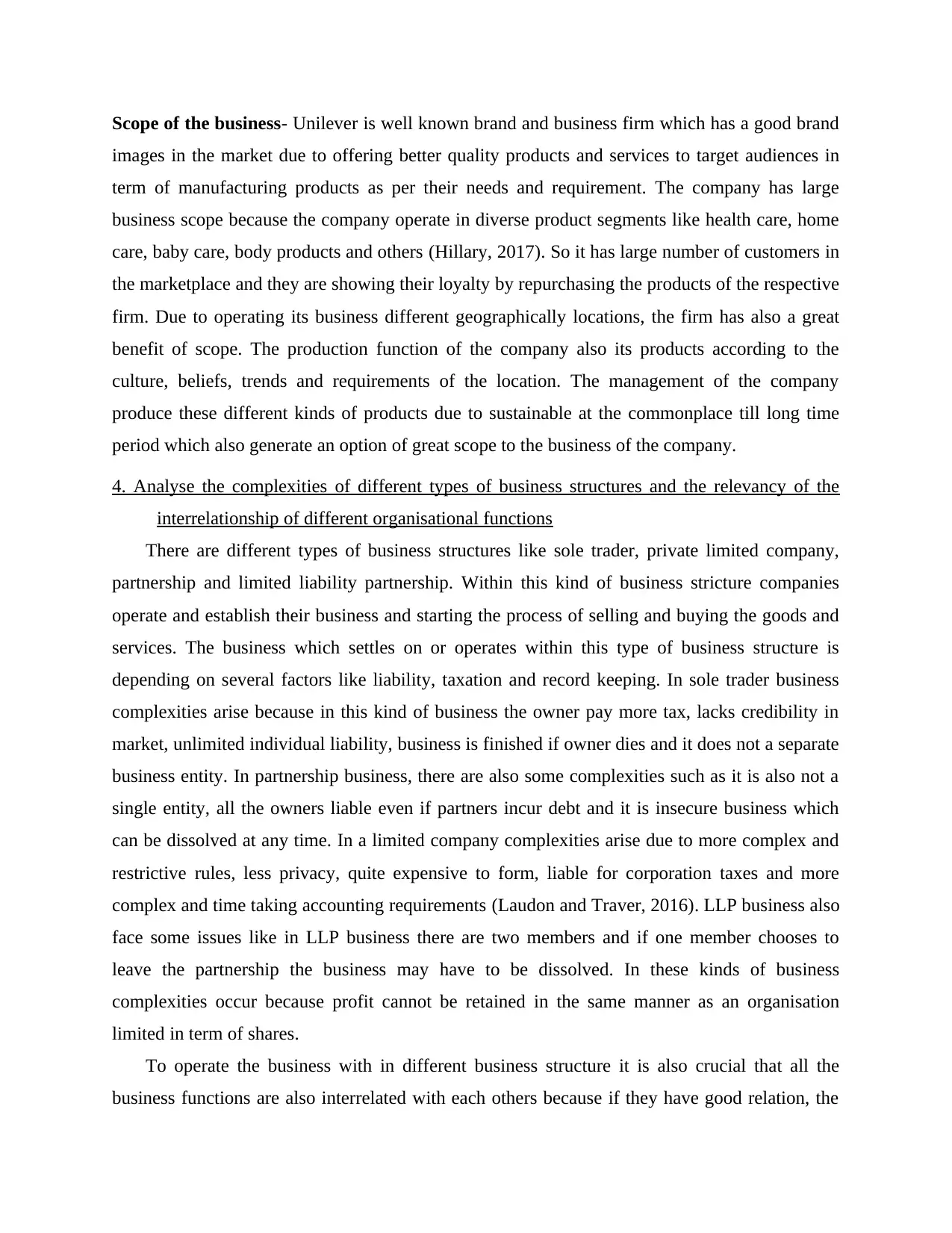
Scope of the business- Unilever is well known brand and business firm which has a good brand
images in the market due to offering better quality products and services to target audiences in
term of manufacturing products as per their needs and requirement. The company has large
business scope because the company operate in diverse product segments like health care, home
care, baby care, body products and others (Hillary, 2017). So it has large number of customers in
the marketplace and they are showing their loyalty by repurchasing the products of the respective
firm. Due to operating its business different geographically locations, the firm has also a great
benefit of scope. The production function of the company also its products according to the
culture, beliefs, trends and requirements of the location. The management of the company
produce these different kinds of products due to sustainable at the commonplace till long time
period which also generate an option of great scope to the business of the company.
4. Analyse the complexities of different types of business structures and the relevancy of the
interrelationship of different organisational functions
There are different types of business structures like sole trader, private limited company,
partnership and limited liability partnership. Within this kind of business stricture companies
operate and establish their business and starting the process of selling and buying the goods and
services. The business which settles on or operates within this type of business structure is
depending on several factors like liability, taxation and record keeping. In sole trader business
complexities arise because in this kind of business the owner pay more tax, lacks credibility in
market, unlimited individual liability, business is finished if owner dies and it does not a separate
business entity. In partnership business, there are also some complexities such as it is also not a
single entity, all the owners liable even if partners incur debt and it is insecure business which
can be dissolved at any time. In a limited company complexities arise due to more complex and
restrictive rules, less privacy, quite expensive to form, liable for corporation taxes and more
complex and time taking accounting requirements (Laudon and Traver, 2016). LLP business also
face some issues like in LLP business there are two members and if one member chooses to
leave the partnership the business may have to be dissolved. In these kinds of business
complexities occur because profit cannot be retained in the same manner as an organisation
limited in term of shares.
To operate the business with in different business structure it is also crucial that all the
business functions are also interrelated with each others because if they have good relation, the
images in the market due to offering better quality products and services to target audiences in
term of manufacturing products as per their needs and requirement. The company has large
business scope because the company operate in diverse product segments like health care, home
care, baby care, body products and others (Hillary, 2017). So it has large number of customers in
the marketplace and they are showing their loyalty by repurchasing the products of the respective
firm. Due to operating its business different geographically locations, the firm has also a great
benefit of scope. The production function of the company also its products according to the
culture, beliefs, trends and requirements of the location. The management of the company
produce these different kinds of products due to sustainable at the commonplace till long time
period which also generate an option of great scope to the business of the company.
4. Analyse the complexities of different types of business structures and the relevancy of the
interrelationship of different organisational functions
There are different types of business structures like sole trader, private limited company,
partnership and limited liability partnership. Within this kind of business stricture companies
operate and establish their business and starting the process of selling and buying the goods and
services. The business which settles on or operates within this type of business structure is
depending on several factors like liability, taxation and record keeping. In sole trader business
complexities arise because in this kind of business the owner pay more tax, lacks credibility in
market, unlimited individual liability, business is finished if owner dies and it does not a separate
business entity. In partnership business, there are also some complexities such as it is also not a
single entity, all the owners liable even if partners incur debt and it is insecure business which
can be dissolved at any time. In a limited company complexities arise due to more complex and
restrictive rules, less privacy, quite expensive to form, liable for corporation taxes and more
complex and time taking accounting requirements (Laudon and Traver, 2016). LLP business also
face some issues like in LLP business there are two members and if one member chooses to
leave the partnership the business may have to be dissolved. In these kinds of business
complexities occur because profit cannot be retained in the same manner as an organisation
limited in term of shares.
To operate the business with in different business structure it is also crucial that all the
business functions are also interrelated with each others because if they have good relation, the
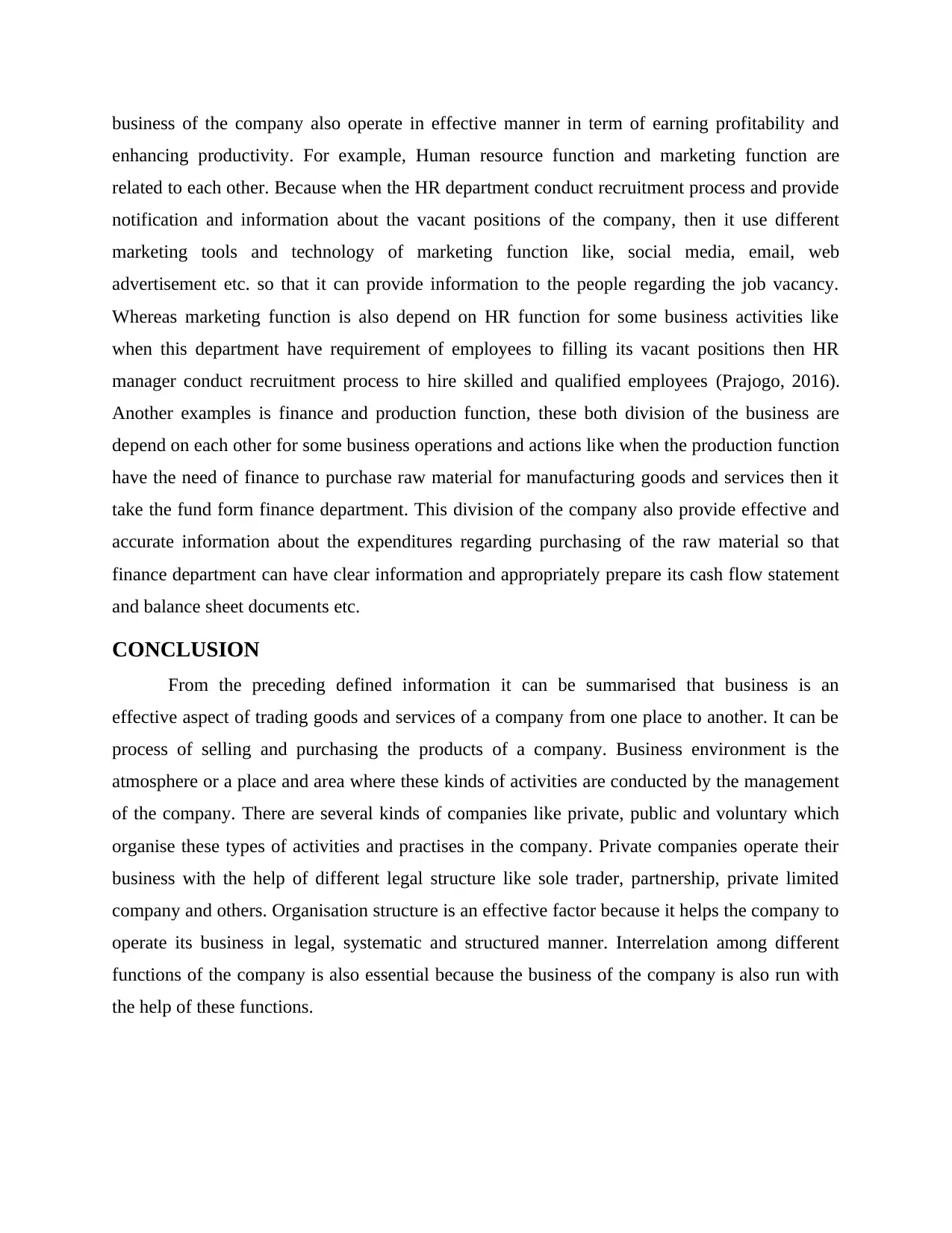
business of the company also operate in effective manner in term of earning profitability and
enhancing productivity. For example, Human resource function and marketing function are
related to each other. Because when the HR department conduct recruitment process and provide
notification and information about the vacant positions of the company, then it use different
marketing tools and technology of marketing function like, social media, email, web
advertisement etc. so that it can provide information to the people regarding the job vacancy.
Whereas marketing function is also depend on HR function for some business activities like
when this department have requirement of employees to filling its vacant positions then HR
manager conduct recruitment process to hire skilled and qualified employees (Prajogo, 2016).
Another examples is finance and production function, these both division of the business are
depend on each other for some business operations and actions like when the production function
have the need of finance to purchase raw material for manufacturing goods and services then it
take the fund form finance department. This division of the company also provide effective and
accurate information about the expenditures regarding purchasing of the raw material so that
finance department can have clear information and appropriately prepare its cash flow statement
and balance sheet documents etc.
CONCLUSION
From the preceding defined information it can be summarised that business is an
effective aspect of trading goods and services of a company from one place to another. It can be
process of selling and purchasing the products of a company. Business environment is the
atmosphere or a place and area where these kinds of activities are conducted by the management
of the company. There are several kinds of companies like private, public and voluntary which
organise these types of activities and practises in the company. Private companies operate their
business with the help of different legal structure like sole trader, partnership, private limited
company and others. Organisation structure is an effective factor because it helps the company to
operate its business in legal, systematic and structured manner. Interrelation among different
functions of the company is also essential because the business of the company is also run with
the help of these functions.
enhancing productivity. For example, Human resource function and marketing function are
related to each other. Because when the HR department conduct recruitment process and provide
notification and information about the vacant positions of the company, then it use different
marketing tools and technology of marketing function like, social media, email, web
advertisement etc. so that it can provide information to the people regarding the job vacancy.
Whereas marketing function is also depend on HR function for some business activities like
when this department have requirement of employees to filling its vacant positions then HR
manager conduct recruitment process to hire skilled and qualified employees (Prajogo, 2016).
Another examples is finance and production function, these both division of the business are
depend on each other for some business operations and actions like when the production function
have the need of finance to purchase raw material for manufacturing goods and services then it
take the fund form finance department. This division of the company also provide effective and
accurate information about the expenditures regarding purchasing of the raw material so that
finance department can have clear information and appropriately prepare its cash flow statement
and balance sheet documents etc.
CONCLUSION
From the preceding defined information it can be summarised that business is an
effective aspect of trading goods and services of a company from one place to another. It can be
process of selling and purchasing the products of a company. Business environment is the
atmosphere or a place and area where these kinds of activities are conducted by the management
of the company. There are several kinds of companies like private, public and voluntary which
organise these types of activities and practises in the company. Private companies operate their
business with the help of different legal structure like sole trader, partnership, private limited
company and others. Organisation structure is an effective factor because it helps the company to
operate its business in legal, systematic and structured manner. Interrelation among different
functions of the company is also essential because the business of the company is also run with
the help of these functions.
⊘ This is a preview!⊘
Do you want full access?
Subscribe today to unlock all pages.

Trusted by 1+ million students worldwide
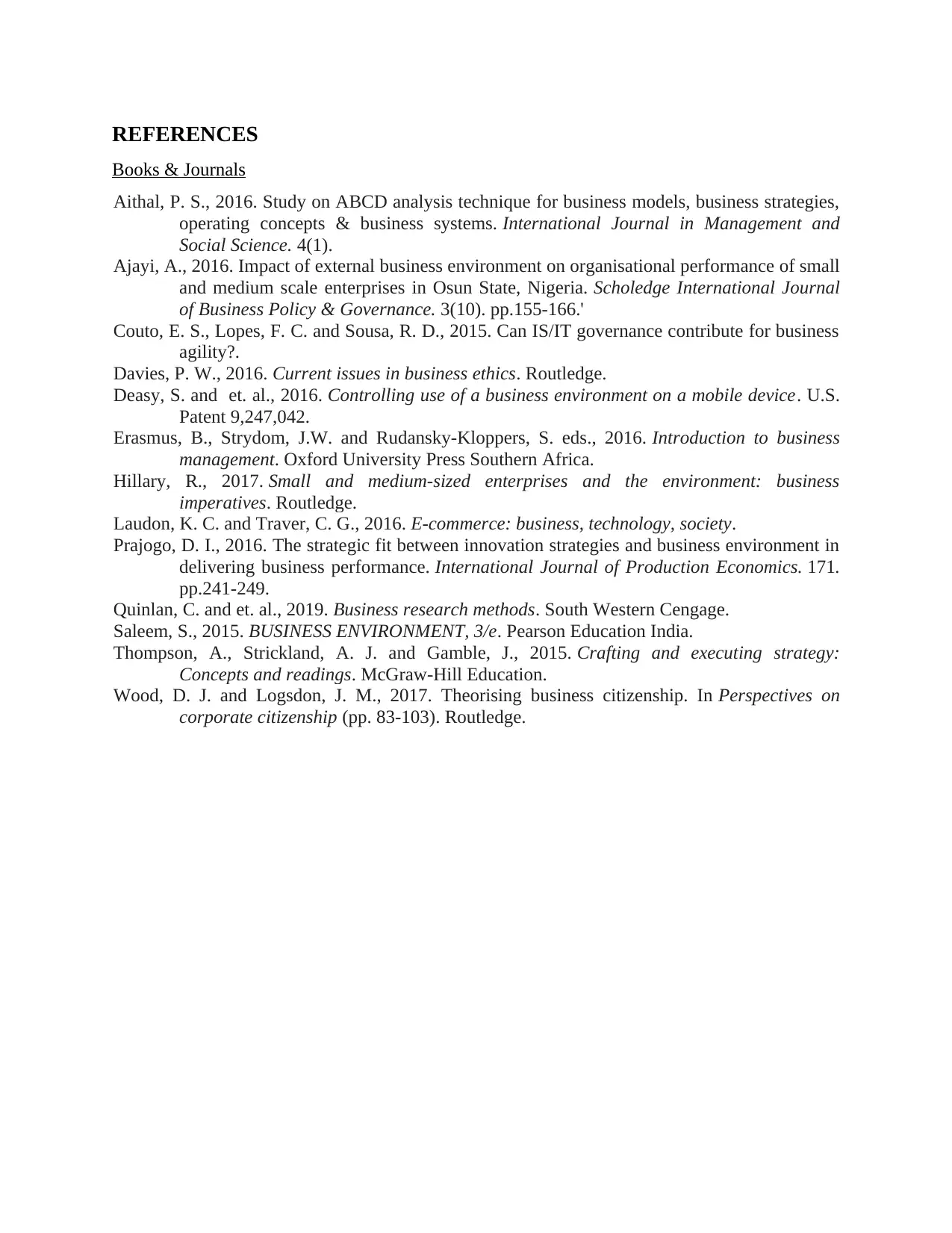
REFERENCES
Books & Journals
Aithal, P. S., 2016. Study on ABCD analysis technique for business models, business strategies,
operating concepts & business systems. International Journal in Management and
Social Science. 4(1).
Ajayi, A., 2016. Impact of external business environment on organisational performance of small
and medium scale enterprises in Osun State, Nigeria. Scholedge International Journal
of Business Policy & Governance. 3(10). pp.155-166.'
Couto, E. S., Lopes, F. C. and Sousa, R. D., 2015. Can IS/IT governance contribute for business
agility?.
Davies, P. W., 2016. Current issues in business ethics. Routledge.
Deasy, S. and et. al., 2016. Controlling use of a business environment on a mobile device. U.S.
Patent 9,247,042.
Erasmus, B., Strydom, J.W. and Rudansky-Kloppers, S. eds., 2016. Introduction to business
management. Oxford University Press Southern Africa.
Hillary, R., 2017. Small and medium-sized enterprises and the environment: business
imperatives. Routledge.
Laudon, K. C. and Traver, C. G., 2016. E-commerce: business, technology, society.
Prajogo, D. I., 2016. The strategic fit between innovation strategies and business environment in
delivering business performance. International Journal of Production Economics. 171.
pp.241-249.
Quinlan, C. and et. al., 2019. Business research methods. South Western Cengage.
Saleem, S., 2015. BUSINESS ENVIRONMENT, 3/e. Pearson Education India.
Thompson, A., Strickland, A. J. and Gamble, J., 2015. Crafting and executing strategy:
Concepts and readings. McGraw-Hill Education.
Wood, D. J. and Logsdon, J. M., 2017. Theorising business citizenship. In Perspectives on
corporate citizenship (pp. 83-103). Routledge.
Books & Journals
Aithal, P. S., 2016. Study on ABCD analysis technique for business models, business strategies,
operating concepts & business systems. International Journal in Management and
Social Science. 4(1).
Ajayi, A., 2016. Impact of external business environment on organisational performance of small
and medium scale enterprises in Osun State, Nigeria. Scholedge International Journal
of Business Policy & Governance. 3(10). pp.155-166.'
Couto, E. S., Lopes, F. C. and Sousa, R. D., 2015. Can IS/IT governance contribute for business
agility?.
Davies, P. W., 2016. Current issues in business ethics. Routledge.
Deasy, S. and et. al., 2016. Controlling use of a business environment on a mobile device. U.S.
Patent 9,247,042.
Erasmus, B., Strydom, J.W. and Rudansky-Kloppers, S. eds., 2016. Introduction to business
management. Oxford University Press Southern Africa.
Hillary, R., 2017. Small and medium-sized enterprises and the environment: business
imperatives. Routledge.
Laudon, K. C. and Traver, C. G., 2016. E-commerce: business, technology, society.
Prajogo, D. I., 2016. The strategic fit between innovation strategies and business environment in
delivering business performance. International Journal of Production Economics. 171.
pp.241-249.
Quinlan, C. and et. al., 2019. Business research methods. South Western Cengage.
Saleem, S., 2015. BUSINESS ENVIRONMENT, 3/e. Pearson Education India.
Thompson, A., Strickland, A. J. and Gamble, J., 2015. Crafting and executing strategy:
Concepts and readings. McGraw-Hill Education.
Wood, D. J. and Logsdon, J. M., 2017. Theorising business citizenship. In Perspectives on
corporate citizenship (pp. 83-103). Routledge.
1 out of 7
Related Documents
Your All-in-One AI-Powered Toolkit for Academic Success.
+13062052269
info@desklib.com
Available 24*7 on WhatsApp / Email
![[object Object]](/_next/static/media/star-bottom.7253800d.svg)
Unlock your academic potential
Copyright © 2020–2025 A2Z Services. All Rights Reserved. Developed and managed by ZUCOL.





